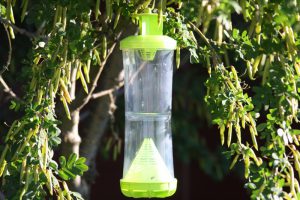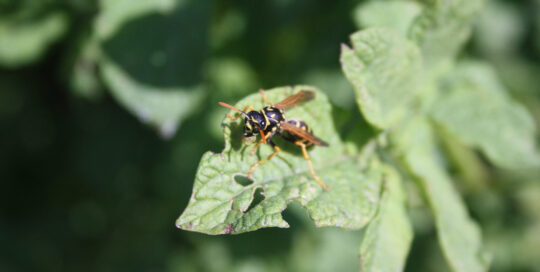Trapping Yellowjackets and Wasps
Views: 3212

Summer is in its full glory, and so are the yellowjackets and wasps.
This spring I was sent the Rescue W-H-Y (Wasp, Hornet, and Yellowjacket) trap to help reduce the problem. I’ve never used a trap for them, but we tend to have a serious issue by mid-summer. It’s no fun to eat dinner on the picnic table with yellowjackets trying to sneak a bite. In fact the only thing I don’t like about picking raspberries is trying not to grab a yellowjacket or wasp while harvesting.
Rescue W-H-Y Trap
The Rescue W-H-Y trap attracts 5 species of wasps and hornets (both European and those nasty bald-face hornets), and 12 species of yellowjackets.
I didn’t know there were that many! The directions say to hang it at least 20 feet away from the fruit and vegetable garden, so we put it on the clothesline. It didn’t take long to start catching them. But, since we have hot, dry weather on the horizon, I moved it to the caragana bush on the side of the house to keep it out of the direct sun. I think it’ll be more effective that way when it’s in the mid-90s.
I was impressed when we loaded the trap, because it has several attractants and ways for the lovelies to enter it. There’s a bottom area baited with attractant poured onto a cloth disk. The yellowjackets can go through the bottom holes, where they are trapped. The top has an attractant in a vile, as well as one that drowns them. It’s a pretty effective set up. The attractant lasts for a couple of weeks before it needs changed.
One concern I had was whether the honeybees from the hive would find it irresistible. I didn’t see any attempt to enter the trap, and when I asked if there’s a risk of it, I was assured the attractants are specific to the targeted species. And even though I know the wasps and yellowjackets are good for the garden and pollination, it’s one of those things where when they’re all over us, it’s time to do something.
Avoiding Yellowjackets in Summer
Besides the trap, there are other things you can do to minimize problems with these flying, sometimes stinging, insects.
One of the greatest tasks is to keep food out of their reach, as much as possible. If you eat outside during the summer, as we do, clear the plates quickly. If food sits on the table, you’ll bring in the yellowjackets.
And as fruit ripens in the garden or in the orchard, it’s important to pick it up as often as possible. I can’t get over how quickly yellowjackets descend upon fruit dropped onto the ground. But be careful. I’ve been stung a fair number of times picking up apples that had yellowjackets clinging to the bottom.
Dealing with wasps, hornets, and yellowjackets is just part of summertime. Hang a few traps, pick up your food, and try your best not to squeeze ‘em!
Meet Amy Grisak
Amy is a freelance author and photographer in Great Falls, MT who specializes in gardening, foods, and sustainable agriculture. She provides information on every kind…
Amy's Recent Posts

Looking into the Crystal Ball for a Pest Report








